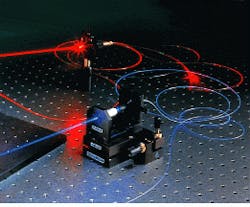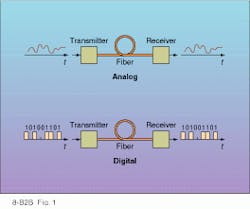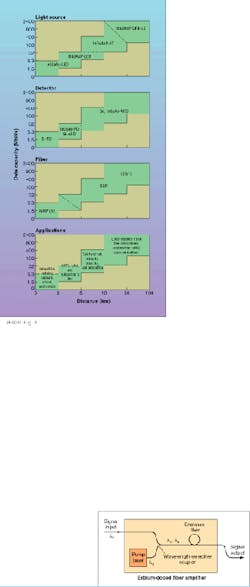Fiberoptic transmission technology has revolutionized telecommunications
When you pick up the phone and place a long-distance call, chances are very good that your conversation is being carried by light waves over hundreds or thousands of miles of optical fiber. The technology has been around for only 20 years, yet fiberoptic communications has already become the backbone of the information superhighway. Not since Alexander Graham Bell’s invention of the telephone has communications experienced such meteoric or revolutionary development, and nearly all of it is made possible by electro-optics.
Ironically, it was Bell himself who invented one of the earliest light-wave communications devices in 1880. Bell’s "photophone" used a flexible diaphragm to modulate a beam of sunlight and a selenium photodetector as a receiver. Current fluctuations generated in the photoconductive selenium by the modulated light beam were fed through a transducer to recreate the original sound. But what made the photophone impractical for long-distance communications was the incoherent light and its free-space transmission through the atmosphere. The advent of lasers in 1960 and low-loss optical fiber in 1970 changed all that.
Modulating the light source
Fiberoptic communications systems offer a unique set of solutions (and problems) to the monumental task of moving mountains of information from one location to another, but, like any form of communication, the signal to be transmitted must be encoded onto the carrier at the source (transmitter) and decoded from the carrier at the destination (receiver).
When the carrier is a light wave, signal encoding is physically done either through direct modulation or external modulation of the light source. For example, varying the current of a diode laser (and therefore its light output) is a form of direct modulation—the prevailing form, in fact. Modulating the intensity of a CW Nd:YAG laser beam with a Pockels cell is a form of external modulation.
Within these two modulation methods exist a variety of signal-encoding schemes that can be classified as either analog or digital. Analog transmitters change the amplitude (intensity), phase, or frequency of a light wave in a smooth, continuous fashion, while digital transmitters shift these same attributes between distinct states, like the dots and dashes of Morse code (see Fig. 1).The type of modulation and encoding used in a fiberoptic transmitter depends on a number of factors, but some light sources are better suited for certain schemes than others. For instance, the broad spectral output of light-emitting diodes (LEDs) precludes them from modulation techniques that require a stable monochromatic wavefront, such as phase and frequency modulation. For LED fiberoptic transmitters, then, intensity modulation is the best direct encoding method. This is also true of low-coherence diode lasers. Nevertheless, frequency or phase modulation can be achieved indirectly with these light sources if the modulation is first performed on an electronic subcarrier and the subcarrier is then used to modulate the intensity of the source.
The compact, solid-state structure of LEDs and diode lasers, as well as their compatibility with direct intensity modulation, has made them overwhelmingly successful for fiberoptic communications—particularly diode lasers. And now the invention of stable, tunable, single-frequency diode lasers such as distributed-feedback (DFB) lasers and distributed-Bragg-reflector (DBR) cavities has stimulated the growth of coherent fiberoptic communications systems for external modulation of phase or frequency.
Coherent communications systems actually require at least two single-frequency lasers—one at the transmitter and one at the receiver. With this arrangement, modulated light from the transmitting laser can be heterodyned (or homodyned) with the brighter light from the receiver’s laser, which is called a local oscillator (see Fig. 2). The result is a hundredfold improvement in receiver sensitivity over simpler systems that detect the light signal directly (direct detection).Modulation schemes for coherent communications systems include amplitude shift keying, frequency shift keying, phase shift keying (PSK), and differential phase shift keying. Homodyne PSK offers the highest sensitivity of any coherent detection system.
Another big advantage of coherent optical communications systems is that they allow a narrower channel spacing for wavelength-division multiplexing (WDM). Multiplexing refers to any of several techniques used to pack more information on a single fiber by simultaneously transmitting several signals over the same fiber. To avoid senseless gibberish at the receiving end, each signal is uniquely tagged in a way that the receiver can recognize. WDM accomplishes this by delivering each signal on a slightly different laser frequency that is then optically filtered by the receiver.
Besides WDM, two other important kinds of multiplexing are time-division multiplexing (TDM) and frequency-division multiplexing (FDM). TDM segregates samples of each signal into separate time slots that the receiver can clock off individually. But with FDM, each signal is carried on a separate subcarrier frequency that can be electronically filtered out by the receiver.
Semiconductor sources and detectors
However, fiber loss and dispersion are of little concern in applications such as intraoffice communications and local-area networks. Here, distances are short and data rates are usually low, allowing low-cost communications systems equipped with aluminum gallium arsenide (AlGaAs) LEDs, multimode fiber, and silicon (Si) photodetectors to be used. The LEDs of these so-called first-generation systems are either surface- or edge-emitting and emit light in the 0.87-µm region, where fiber dispersion and loss are both high. This wavelength also happens to be well suited for silicon PIN and avalanche photodiodes.
For higher data rates or longer distances, though, sources and detectors must operate near the 1.3- or 1.55-µm regions, which are defined as second- and third-generation fiberoptic systems, respectively. At the 1.3-µm, zero-dispersion wavelength, LEDs fabricated from indium gallium arsenic phosphide (InGaAsP) can be used for short-haul communications up to about 5 km. These second-generation sources can accommodate data rates of several hundred megabits per second, but longer distances or faster data rates demand the higher coherence and modulation speeds of InGaAsP lasers, which can be tailored to emit light at 1.3 or 1.55 µm. Of course, 1.55-µm InGaAsP sources are designed for long-haul applications, where signal attenuation becomes important.
Silicon photodetectors cannot be used for second- or third-generation fiberoptic communications systems, because the 1.1-eV bandgap makes silicon relatively transparent at these wavelengths (cutoff wavelength: 1.13 µm). At 1.3 and 1.55 µm, PIN and avalanche photodiode (APD) photodetectors must be fabricated from narrower-bandgap semiconductor materials such as InGaAs and germanium (Ge). These detectors have good responsivities and fast response times, which make for sensitive receivers with bandwidths up to 60 GHz. Schottky-barrier photodiodes provide even faster response times, leading to bandwidths in the 100-GHz range.
When integrated into a complete fiberoptic communications system, semiconductor light sources and detectors can achieve bandwidths of 20 GHz or more for a wide range of applications. (See Fig. 3 for the data rates and transmission range of typical sources, detectors, optical fiber, and communications applications.)
Fiber lasers and amplifiers
The critical challenge of long-haul fiberoptic communications over distances of more than 100 km is how to amplify the optical signal. Until recently, the solution has always been to place repeaters at regular intervals along the fiber link. For example, a 7500-km transatlantic link uses about 100 repeaters—one every 75 km.
Repeaters are electro-optic devices that work a little like light-wave communications systems in reverse. A photodiode (usually a low-noise PIN or APD detector) first converts the attenuated light wave into an electronic signal that is amplified and regenerated. A diode laser then transforms the electronic signal back into light for further transmission down the fiber.
The problem with repeaters is that the complex circuitry fixes the electronic speed of each device, making upgrades difficult and costly. Repeaters also complicate WDM systems, because the channels must be handled in parallel.
In 1985-1986, however, researchers at the University of Southampton (Southampton, England) developed an all-optical way to amplify the 1.55-µm light of long-haul fiberoptic systems. By doping a 3-m-long silica fiber core with erbium and optically pumping it at 650 nm, they generated 125 dB of gain for a 1.53-µm signal. Their achievement touched off a worldwide investigation into fiber amplifiers for optical communications that has culminated in a variety of important developments, not the least of which is the evolution of all-optical transoceanic fiber links.
Commercial erbium-doped fiber amplifiers typically are end-pumped by a semiconductor laser at either 980 or 1480 nm. Pump radiation is introduced to the core by a dichroic coupler (beamsplitter), leaving the signal and pump waves to travel through the core together (see Fig. 4). Because the narrow core keeps the pump radiation concentrated in a small volume, just a few milliwatts of pump power will generate gain at the signal wavelength. To avoid unwanted resonance absorption of the signal wave by unexcited erbium atoms, the entire length of the doped fiber through which the signal travels must be pumped.The advent of these optical amplifiers has already helped define a whole new fifth generation of fiberoptic communications devices and systems to succeed the fourth-generation of coherent optical communications systems mentioned earlier. For example, the search for an effective optical amplifier at 1.3 µm has produced praseodymium- and neodymium-doped fiber amplifiers. One of the most promising candidates at this important wavelength seems to be praseodymium-doped ZBLAN (a fluorozirconate compound).
Another system under development is the distributed fiber amplifier, which consists of a lightly doped fiber core that when pumped generates just enough gain to overcome the natural attenuation of the glass. Long lengths of these "no-loss" fibers can be pumped via an oversized, transparent cladding (cladding pumping).
Still another fifth-generation device is the fiber laser, which is basically a fiber amplifier placed between two parallel mirrors. Conventional mirrors can be used, but a more elegant and practical approach is to form the mirrors from Bragg gratings written directly into the photosensitive core. A great deal of research on fiber lasers has yielded a plethora of new devices, including upconversion lasers with outputs at the blue end of the spectrum (see photo at top of this page).
But the most exciting field of inquiry into fifth-generation devices involves solitons and other nonlinear fiberoptic effects. Optical solitons consist of femtosecond light pulses with high peak powers that can travel through thousands of miles of fiber without changing their temporal shape. This is because the nonlinear optical effects of these intense pulses essentially render the fiber "dispersionless."
Before long, optical transmitters based on these nascent technologies will be spewing out data at trillions of bits per second. And that’s enough to satisfy even the most voracious commuter on the information highway (at least for a picosecond or two).
FURTHER READING
Emmanuel Desurvire, Erbium-Doped Fiber Amplifiers: Principles and Applications, John Wiley & Sons, Inc., New York, NY (1994).
P. W. France, ed., Optical Fibre Lasers and Amplifiers, CRC Press Inc., Boca Raton, FL (1991).
Donald G. Baker, Fiber Optic Design and Applications, Reston Publishing Co. Inc., Reston, VA (1985).
Peter K. Cheo, Fiber Optics and Optoelectronics, Prentice Hall, Englewood Cliffs, NJ (1990).
Donald G. Baker, Monomode Fiber-Optic Design, Van Nostrand Reinhold Co., New York, NY (1987).
Chai Yeh, Handbook of Fiber Optics: Theory and Applications, Academic Press Inc., San Diego, CA (1990).
B. A. Saleh and M. C. Teich, Fundamentals of Photonics, John Wiley & Sons, New York, NY (1991).
About the Author
Thomas V. Higgins
Contributing Editor
Thomas V. Higgins was a contributing editor for Laser Focus World, covering science and technology.




